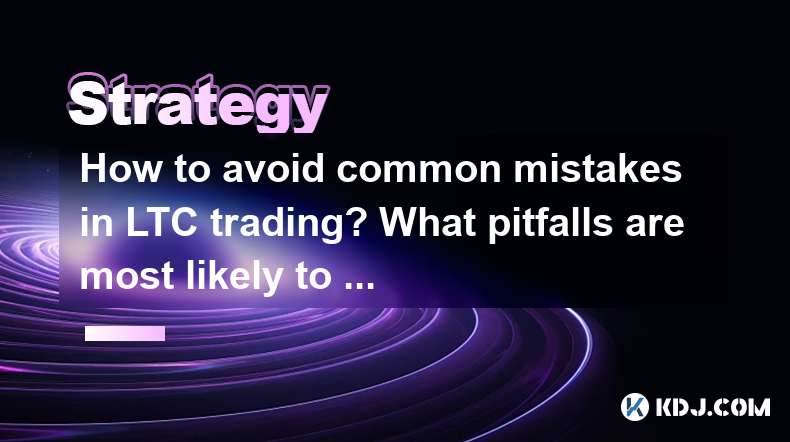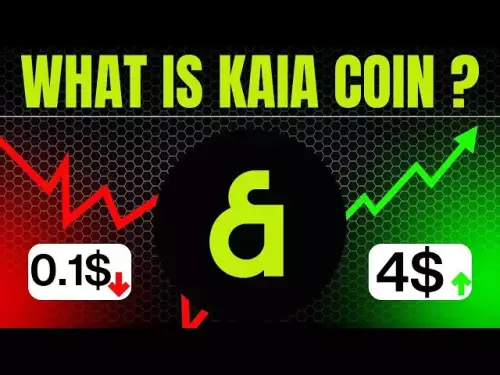-
 bitcoin
bitcoin $112715.707551 USD
-1.71% -
 ethereum
ethereum $4101.475385 USD
-3.01% -
 tether
tether $1.000644 USD
-0.02% -
 bnb
bnb $1207.619465 USD
-6.77% -
 xrp
xrp $2.501451 USD
-3.98% -
 solana
solana $202.947124 USD
-3.32% -
 usd-coin
usd-coin $1.000295 USD
0.04% -
 dogecoin
dogecoin $0.203884 USD
-4.47% -
 tron
tron $0.317154 USD
-1.72% -
 cardano
cardano $0.695009 USD
-4.43% -
 hyperliquid
hyperliquid $38.853961 USD
-8.23% -
 chainlink
chainlink $18.988674 USD
-4.64% -
 ethena-usde
ethena-usde $1.000233 USD
-0.03% -
 stellar
stellar $0.337050 USD
-3.63% -
 bitcoin-cash
bitcoin-cash $536.861728 USD
-1.28%
How to avoid common mistakes in LTC trading? What pitfalls are most likely to be encountered by novices?
Novice LTC traders often dive in without research, ignore risk management, trade emotionally, fall for scams, overtrade, chase losses, and neglect analysis, leading to significant financial losses.
Apr 30, 2025 at 05:15 pm

Trading Litecoin (LTC) can be an exciting venture, but it is fraught with potential pitfalls that can lead to significant losses, especially for novices. Understanding these common mistakes and learning how to avoid them is crucial for anyone looking to trade LTC successfully. This article will explore the most frequent errors made by LTC traders and provide practical advice on how to sidestep these pitfalls.
Lack of Research and Understanding
One of the most common mistakes among novice LTC traders is diving into the market without sufficient research and understanding of the cryptocurrency. Trading without a solid foundation of knowledge can lead to uninformed decisions and significant financial losses.
To avoid this pitfall, it's essential to:
- Educate yourself about Litecoin: Understand its history, technology, and use cases. Websites like the Litecoin Foundation and reputable cryptocurrency news outlets can provide valuable insights.
- Learn about the crypto market: Familiarize yourself with market trends, the factors that influence LTC prices, and the overall dynamics of the cryptocurrency market.
- Stay updated: Follow reliable sources for the latest news and developments related to Litecoin and the broader crypto market.
Ignoring Risk Management
Another critical mistake that many new traders make is ignoring risk management principles. Failing to manage risk can quickly deplete your trading capital, leaving you with nothing to trade.
Effective risk management strategies include:
- Setting stop-loss orders: Determine a price level at which you will sell your LTC to limit potential losses. For example, if you buy LTC at $100, you might set a stop-loss order at $90 to cap your potential loss at 10%.
- Diversifying your portfolio: Don't put all your funds into LTC. Spread your investments across different cryptocurrencies to mitigate risk.
- Only investing what you can afford to lose: Never trade with money that you need for essential expenses. Cryptocurrency trading is risky, and you should be prepared to lose your investment.
Emotional Trading
Emotional trading is a significant pitfall for many LTC traders, particularly those new to the market. Letting emotions drive your trading decisions can lead to impulsive actions and poor judgment.
To combat emotional trading, consider these strategies:
- Develop a trading plan: Create a detailed plan that outlines your entry and exit points, risk tolerance, and overall trading strategy. Stick to this plan regardless of market fluctuations.
- Use trading journals: Keep a record of your trades, including the rationale behind each decision. Reviewing your journal can help you identify patterns in your emotional responses and improve your decision-making process.
- Take breaks: If you find yourself becoming overly emotional about your trades, step away from the market for a while. Returning with a clear mind can help you make more rational decisions.
Falling for Scams and Fraud
The cryptocurrency space is rife with scams and fraudulent schemes, and LTC traders are not immune to these dangers. Falling for scams can result in the loss of your entire investment.
To protect yourself from scams, follow these guidelines:
- Verify the authenticity of trading platforms: Only use reputable exchanges and wallets to buy, sell, and store your LTC. Research user reviews and regulatory compliance before committing to a platform.
- Be wary of too-good-to-be-true offers: If an investment opportunity promises unusually high returns with little to no risk, it's likely a scam. Always conduct thorough due diligence before investing.
- Protect your private keys: Never share your private keys or seed phrases with anyone. Use secure methods to store your LTC, such as hardware wallets, to safeguard your assets.
Overtrading and Chasing Losses
Overtrading and chasing losses are common mistakes that can lead to a downward spiral in your LTC trading journey. Overtrading can result in excessive transaction fees and increased risk exposure, while chasing losses can exacerbate financial losses.
To avoid these pitfalls, consider the following:
- Set trading limits: Establish a maximum number of trades you will execute within a given period. This can help prevent impulsive trading and reduce the risk of overtrading.
- Avoid revenge trading: If you experience a loss, resist the urge to immediately jump back into the market to recoup your losses. Take time to analyze what went wrong and adjust your strategy accordingly.
- Focus on quality over quantity: Instead of making frequent small trades, focus on well-researched, high-quality trades that align with your overall trading strategy.
Neglecting Technical and Fundamental Analysis
Many novice LTC traders neglect the importance of technical and fundamental analysis, which can lead to poor trading decisions. Understanding both types of analysis is crucial for making informed trading decisions.
To incorporate technical and fundamental analysis into your trading strategy:
- Learn technical analysis: Study charts, patterns, and indicators to predict future price movements. Tools like moving averages, RSI, and MACD can help you identify potential entry and exit points.
- Conduct fundamental analysis: Evaluate the underlying factors that can affect LTC's value, such as network developments, adoption rates, and regulatory news. Websites like CoinMarketCap and CryptoCompare offer valuable data for fundamental analysis.
- Combine both approaches: Use technical analysis to time your trades and fundamental analysis to understand the broader market context. This holistic approach can enhance your trading decisions.
FAQs
Q: How can I tell if a Litecoin trading platform is reputable?A: To determine if a Litecoin trading platform is reputable, look for user reviews on independent sites, check for regulatory compliance, and ensure the platform has robust security measures in place. Additionally, reputable platforms often have transparent fee structures and responsive customer support.
Q: What are some common signs of a cryptocurrency scam?A: Common signs of a cryptocurrency scam include promises of high returns with little to no risk, unsolicited offers, requests for personal information or private keys, and pressure to invest quickly. Always conduct thorough research and verify the legitimacy of any investment opportunity.
Q: How often should I review my trading plan?A: It's a good practice to review your trading plan regularly, at least once a month or after significant market events. This allows you to adjust your strategy based on new information and ensure that your plan remains aligned with your trading goals and risk tolerance.
Q: Can I trade Litecoin without using technical analysis?A: While it's possible to trade Litecoin without using technical analysis, doing so can significantly increase your risk. Technical analysis provides valuable insights into market trends and potential price movements, helping you make more informed trading decisions. Combining technical analysis with fundamental analysis can further enhance your trading strategy.
Disclaimer:info@kdj.com
The information provided is not trading advice. kdj.com does not assume any responsibility for any investments made based on the information provided in this article. Cryptocurrencies are highly volatile and it is highly recommended that you invest with caution after thorough research!
If you believe that the content used on this website infringes your copyright, please contact us immediately (info@kdj.com) and we will delete it promptly.
- BTC, ETH, and Crypto Presales: Navigating the Storm with MoonBull & LivLive
- 2025-10-15 11:05:13
- BlackRock's Bitcoin ETF Buzz Down Under: Australia's Crypto Scene Heats Up
- 2025-10-15 11:45:15
- Trump, Bitcoin, and Trump Media: A New York Minute on Crypto's Latest Twist
- 2025-10-15 11:05:13
- Altcoin Season Incoming? Historical Setups and Trends to Watch
- 2025-10-15 11:45:15
- Crypto Scam Crackdown: Cambodian Executive, Bitcoin Seizure, and a $14 Billion Heist
- 2025-10-15 11:10:00
- Bitcoin's Wild Ride: Structural Demand Survives the Liquidation Tsunami
- 2025-10-15 11:10:00
Related knowledge

Practical parameter settings for a Bitcoin multi-timeframe moving average system
Sep 18,2025 at 10:54pm
Optimizing Timeframe Combinations for Bitcoin Trading1. Selecting appropriate timeframes is crucial when building a multi-timeframe moving average sys...

How can I filter out false breakouts in Dogecoin high-frequency trading?
Sep 22,2025 at 01:00am
Understanding False Breakouts in Dogecoin Trading1. A false breakout occurs when Dogecoin's price appears to move beyond a defined support or resistan...

Techniques for identifying tops and bottoms in the Bitcoin on-chain NVT model
Sep 20,2025 at 07:54pm
Understanding the NVT Model in Bitcoin Analysis1. The Network Value to Transactions (NVT) ratio is often described as the 'P/E ratio' of the cryptocur...

What does the surge in open interest in Bitcoincoin futures mean?
Sep 20,2025 at 11:18pm
Understanding the Surge in Dogecoin Futures Open Interest1. A surge in open interest within Dogecoin futures indicates a growing number of active cont...

How can I use the Ethereum USDT premium to gauge market sentiment?
Sep 18,2025 at 11:55pm
Understanding the Ethereum USDT Premium1. The Ethereum USDT premium refers to the price difference between USDT (Tether) traded on Ethereum-based plat...

What should I do if Ethereum staking yields decline?
Sep 20,2025 at 06:18am
Understanding the Causes Behind Declining Ethereum Staking Yields1. The Ethereum network transitioned to a proof-of-stake consensus mechanism with the...

Practical parameter settings for a Bitcoin multi-timeframe moving average system
Sep 18,2025 at 10:54pm
Optimizing Timeframe Combinations for Bitcoin Trading1. Selecting appropriate timeframes is crucial when building a multi-timeframe moving average sys...

How can I filter out false breakouts in Dogecoin high-frequency trading?
Sep 22,2025 at 01:00am
Understanding False Breakouts in Dogecoin Trading1. A false breakout occurs when Dogecoin's price appears to move beyond a defined support or resistan...

Techniques for identifying tops and bottoms in the Bitcoin on-chain NVT model
Sep 20,2025 at 07:54pm
Understanding the NVT Model in Bitcoin Analysis1. The Network Value to Transactions (NVT) ratio is often described as the 'P/E ratio' of the cryptocur...

What does the surge in open interest in Bitcoincoin futures mean?
Sep 20,2025 at 11:18pm
Understanding the Surge in Dogecoin Futures Open Interest1. A surge in open interest within Dogecoin futures indicates a growing number of active cont...

How can I use the Ethereum USDT premium to gauge market sentiment?
Sep 18,2025 at 11:55pm
Understanding the Ethereum USDT Premium1. The Ethereum USDT premium refers to the price difference between USDT (Tether) traded on Ethereum-based plat...

What should I do if Ethereum staking yields decline?
Sep 20,2025 at 06:18am
Understanding the Causes Behind Declining Ethereum Staking Yields1. The Ethereum network transitioned to a proof-of-stake consensus mechanism with the...
See all articles


























![Staking ATH: How To Stake $ATH in October 2025 with 523% APY — [Step-By-Step Guide] Staking ATH: How To Stake $ATH in October 2025 with 523% APY — [Step-By-Step Guide]](/uploads/2025/10/15/cryptocurrencies-news/videos/staking-ath-stake-ath-october-apy-stepstep-guide/68eef94d80903_image_500_375.webp)















































